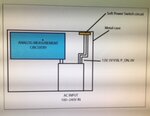Smillsey
Member level 5
Hi all
I have a quick question regarding grounding PCB’s to the chassis.
Do you have your own personal rules as to when you “do” and “don’t”?
I am designing a soft “on/off” switch to control an ATX power supply.
I have currently laid the PCB out and the ground returns flow back to the ATX PSU via directly via a cable loom. They do not flow via the chassis ground.
I see no reason to use the chassis as the ground return for these DC signals, as I do not want ground loops nor do I want to use the aluminium chassis as the ground return.
I will be designing the analog measurement boards next and I plan to run those grounds back to the ATX PSU too.
The ATX design guide doesn’t really mention ground return best practices.
My plan is to only use the chassis as a ground path for the shielding cans.
Does anybody here use the chassis as a return path for anything else?
Thanks
S
I have a quick question regarding grounding PCB’s to the chassis.
Do you have your own personal rules as to when you “do” and “don’t”?
I am designing a soft “on/off” switch to control an ATX power supply.
I have currently laid the PCB out and the ground returns flow back to the ATX PSU via directly via a cable loom. They do not flow via the chassis ground.
I see no reason to use the chassis as the ground return for these DC signals, as I do not want ground loops nor do I want to use the aluminium chassis as the ground return.
I will be designing the analog measurement boards next and I plan to run those grounds back to the ATX PSU too.
The ATX design guide doesn’t really mention ground return best practices.
My plan is to only use the chassis as a ground path for the shielding cans.
Does anybody here use the chassis as a return path for anything else?
Thanks
S
